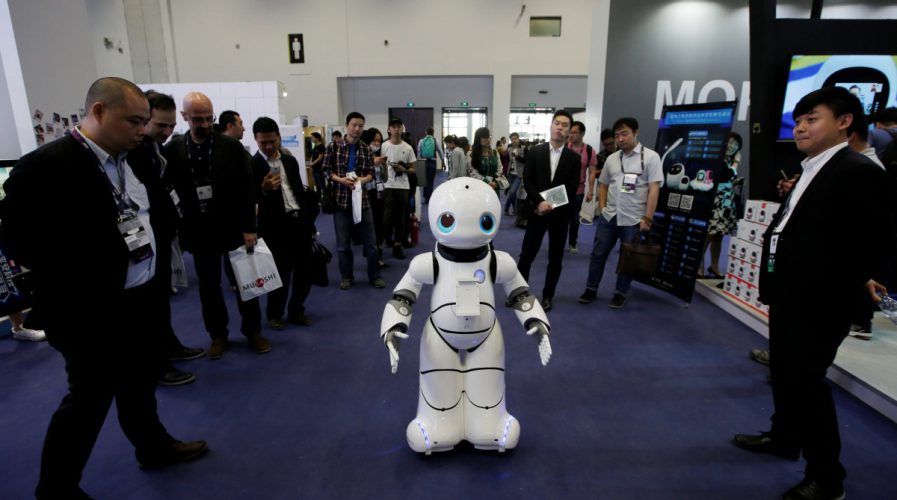
Robots are becoming ubiquitous in our lives, so we need to start thinking about how to turn them into add-ons. Source: Reuters
Here’s how to rethink the role of robots in our lives
WE’VE heard a lot about “killer robots” in the last three months, most notably when Elon Musk lent his name to a group of 116 scientists from 26 different countries around the world in a letter to the UN, urging the organization to take a firm stance against artificial intelligence-powered weapons. We’ve also heard from researchers Cesar Cerrudo and Lucas Apa who found serious vulnerabilities in the cute robots from Softbank and UBTech which turned these seemingly harmless toys into dangerous machines.
But really, we have all heard the old song-and-dance about the dangers of technology, an issue that was popularized by the Terminator film series which saw a network of interlinked robots embark on a crusade to eliminate humanity. At the heart of the series, and all the current anti-technology rhetoric swirling around, is a deep-seated fear of being made irrelevant by automation, as well as a concern that we might not understand the innovations that we have helped create.

Mark Hearn, Director of IoT for Irdeto. Source: Irdeto
Whether or not you buy into the idea that the future is Skynet, or whether you think technology is just another gimmick, it seems like we need a reckoning about how these “killer robots” interact with our lives, and what exactly will be their impact on our society. The rapid growth of the Internet of Things (IoT) devices and networks has made such questions increasingly pertinent.
Tech Wire Asia spoke to Mark Hearn, the director of IoT security for software company, Irdeto, about what he thinks are some ways we can think more complexly about how IoT devices and robots interact, and how we can ensure they are add-ons to our lives rather than detractors.
Why has security of these kinds of technologies been overlooked? If IoT is due to proliferate in many aspects of our lives, why has the security of such technology not become a matter of fact?
Organizations today know that they need to have a cybersecurity strategy in place to protect their intellectual property and sensitive data from getting into the hands of cybercriminals. However, in most industries, companies today look at reducing the cost of producing their goods as much as possible while ensuring that they mitigate the most critical risks to their business.
The primary issue that we are seeing in IoT is that many of these companies are not fully aware of the security risk that they are taking on by connecting their products. A robust security strategy is only effective if tailored to the threats that an organization faces and unfortunately, many organizations do not implement the cybersecurity needed to meet their new risk profile. This, in large part, is why we are seeing increasing numbers of ransomware and malware attacks globally.
SEE ALSO: Elon Musk and other AI, robotics leaders urge UN to ban use of ‘killer robots’
Furthermore, Internet of Things, as a market, is still in its infancy, so security of these IoT systems has often been deprioritized as companies are stretching to get early products to market. As the proliferation of IoT connected devices continues, IoT platforms will converge and become more standardized – this increases the risk to the business and highlights the importance of IoT security.
Why have these manufacturers failed to address the issue quickly?
As the threat landscape continues to evolve rapidly, it’s clear that many manufacturers are failing to learn about what they’re up against from a cybersecurity perspective. The pace of change in business models has not been matched by the evolution of manufacturers’ approaches to security, resulting in a slow or ineffective response when an attack occurs.

The Pepper robot was found to have been extremely vulnerable to hacks from outside forces. Source: Reuters
As consumers demand more flexibility, ease of access and convenience, increasingly companies are relying on connectivity to introduce new or enhanced services, which ultimately introduces openings for hackers. With the increased levels of connectivity to IoT devices, often deployed outside of a company’s IT security perimeter, manufacturers must now think about the protection, updates and upgrades of IoT devices as a critical part of their IoT security strategy.
Where in the past, the security strategy for a device was focused on initial deployment, the world of IoT necessitates that device manufacturers view security strategy as a continually evolving protection of their products and their connectivity to their customers. The ability to dynamically update security on a device is needed to counteract the negative impacts of being hacked and to maintain a positive brand image with customers.
SEE ALSO: Vinclu’s Gatebox AI assistant wants to have a relationship with you
According to the recent Irdeto Global Consumer IoT Security Survey, 90 percent of consumers polled believe it is important that a connected device has security built into the product. Further, 71 percent of respondents felt that the manufacturer had sole or partial responsibility in ensuring the consumer’s device remains secure.
It is challenging for manufacturers to address security issues quickly with the threat landscape constantly evolving. Whether it’s ransomware against trucking fleets, extorting OEMs or malware taking down an IoT infrastructure, the impact of an attack is a worrying thought for companies across the globe. While it is impossible for companies to become hack-proof, a continually evolving security strategy is key to keeping your products more secure than the environment around you.

This complex race to bridge our worlds is taken on by teams across multiple industries dedicated to connecting everything from lamps and washing machines to wrist watches and cars. Source: Shutterstock
Is there any credence to the idea that “killer robots” and Terminator-style technologies could cause us real harm in our everyday lives? Considering issues such as the letter issued to the UN from Elon Musk and other robotics and AI experts, do they have a point with regards to this issue?
It is difficult to predict how this fast-moving market will develop, but it’s clear that the adoption of smart devices is only going to increase as consumers take advantage of the innovative features that connectivity provides. Gartner is predicting that 20.4 billion connected things will be in use by 2020. With security issues dominating the news in IoT, it is easy to envision the result of malicious intent playing out even in today’s connected device.
SEE ALSO: Robots are hackable, but manufacturers are failing to fix the problem – researchers
With recent events in the world, it is easy to see how everyday “tools”, such as an automobile, can be used to harm others. If that tool can be compromised through a cyberattack and scaled to 1000 similar “tools”, the potential damage would be an order of magnitude worse. With the rise of robotics and AI, the impact could be far greater if a hacker is able to alter the learning of near intelligent robot, or even alter the reality that the robot operates in.
As robotics takes over many functions previously requiring a human brain to correctly execute, the importance of securing the purpose of that robot becomes both critical and fundamental. With the introduction of IoT connected devices with minimal security, we are already on the slippery slope to security problems in the time of AI.

Elon Musk and 116 other scientists sent an open letter to the UN expressing concern about unmanned ‘killer robots’ like drones. Source: Shutterstock
To start combatting these threats, businesses today must rely on optimal security to protect their brand, revenue and intellectual property. This starts with understanding how hackers operate and knowing consumer perceptions of cybersecurity and what they expect from businesses supplying connected devices. Companies must implement an ever-evolving defense in depth approach to cybersecurity on their edge devices (whether still in their network, or deployed to the consumer), and continually raise the security bar against the latest attack vectors.
Robots are still going to be an integral part of our lives moving forward. What can the average business person or layman do to equip themselves to deal with questions about safety and security that many may not have thought about yet?
Today’s connected world needs consumers to be vigilant about security threats, and recognize the important role they play in IoT security. The recent Irdeto Global Consumer IoT Security Survey revealed that many consumers are aware of cyberthreats targeting connected devices and the importance of building security into these devices to prevent cyberattacks, but fewer are concerned about their smart devices being hacked.
SEE ALSO: Drone maker Frank Wang becomes Asia’s youngest tech billionaire
Worse, there is a percentage of consumers that feel they are not responsible for the security of their connected devices, assuming that manufacturers are ultimately responsible for security of the product.
With IoT becoming such an integral part of our lives, manufacturers must implement an ever-evolving defense in-depth approach to cybersecurity. However, it is also critical that consumers become more educated on the important role they play in IoT security and make themselves aware of evolving threats to their personal data and their own safety.
READ MORE
- Strategies for Democratizing GenAI
- The criticality of endpoint management in cybersecurity and operations
- Ethical AI: The renewed importance of safeguarding data and customer privacy in Generative AI applications
- How Japan balances AI-driven opportunities with cybersecurity needs
- Deploying SASE: Benchmarking your approach
